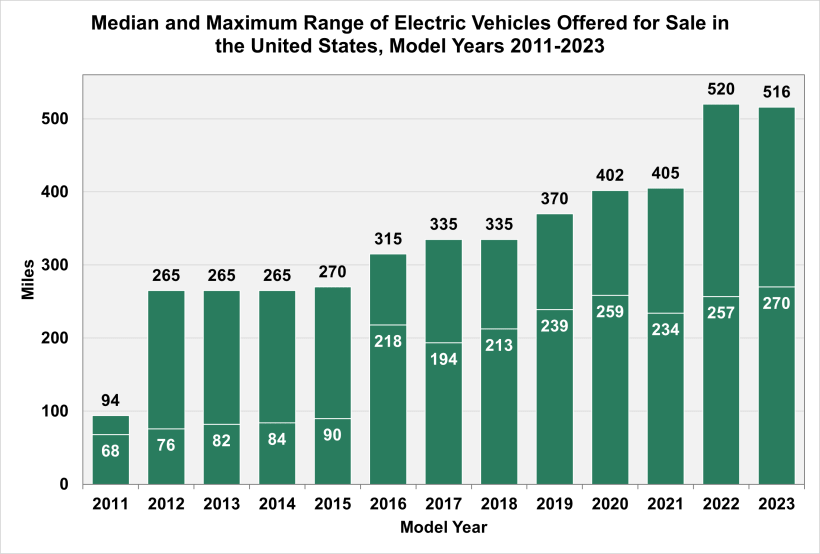
EVs are advancing at a record pace. The median EV range reached 270 miles for 2023 models. That’s 13 miles more than 2022MY vehicles and more than enough to cover the average weekly commute for US drivers.
2023 median EV range covers an average week’s drive
Automakers are developing new tech and materials to enable electric vehicles to travel longer and more efficiently.
According to EPA data, the median EV range hit 270 miles for ’23 model year vehicles. That’s nearly 200 miles more than where it was ten years ago (82). It’s also plenty for an average weekly commute in the US.
The average US driver travels around 37 miles per day, according to figures from the Department of Transportation.
With an average of 259 miles driven weekly, most EVs have plenty of range to cover your weekly commute. And for homeowners, waking up to a full charge beats stopping at the gas station.
Automakers are releasing new, longer-range EVs like the Lucid Air Grand Touring with up to 516 miles EPA estimated range.

Although range is often cited as one of the biggest reasons drivers hold off on buying an electric car, many EVs offer over 300 miles nowadays. There were over 25 EVs that exceeded the 300-mile mark last year. That’s nearly double the number from two years ago.
With several new models rolling out this year, like Jeep’s Wagoneer S with around 400 miles range expected, the number is expected to climb again this year. Here’s a look at the longest range EVs in 2024.
| Rank | Electric Vehicle | EPA est range (miles) |
| 1 | Lucid Air Grand Touring | 516 |
| 2 | Chevy Silverado EV | 450 |
| 3 | Lucid Air Sapphire | 427 |
| 4 | Lucid Air Touring | 425 |
| 5 | Lucid Air Pure | 419 |
| 6 | Tesla Model S | 405 |
| 7 | Rivian R1S Dual-Motor Max Pack | 400 |
| 7 (tie) | Rivian R1T Dual Motor Max Pack | 400 |
| 8 | Hyundai IONIQ 6 LR | 361 |
| 9 | Fisker Ocean Extreme | 360 |
| 10 | Tesla Model 3 LR | 358 |
| 11 | Mercedes EQS 450 Plus | 352 |
| 11 (tie) | Rivian R1S Dual-Motor Large Pack | 352 |
| 11 (tie) | Rivian R1T Dual-Motor Large Pack | 352 |
| 12 | Tesla Model X | 348 |
| 13 | Tesla Model X Plaid | 333 |
| 14 | VinFast VF9 Eco | 330 |
| 15 | BMW iX XDrive50 | 324 |
| 15(tie) | Chevy Blazer EV | 324 |
Average EV prices have also fallen significantly, coming within $2,040 of the average gas-powered vehicle at $50,798. Tesla was slightly below the EV average at $50,051.
Electrek’s Take
Top comment by Jeff S.
Most families with two vehicles and a garage don’t have any EVs yet. I think that’s the low hanging fruit. At least replace one ICE with an EV. You’ll have all the benefits of an EV, including a full battery every morning capable of handling pretty much any daily driving with plenty to spare. And if the speed/reliability of public fast chargers are not quite up to your comfort level standards yet, you can still take the ICE vehicle for the occasional road trip. My family changed one vehicle to an EV and the other vehicle to a hybrid, so now we use about 75% less gas!
270 miles is plenty for a week’s worth of driving with most drivers in the US. That’s a big accomplishment, considering just ten years ago, the median EV range was 82.
Imagine in another ten years? Automakers are racing to release new innovations that improve range and efficiency.
Although 500+ miles range is a bit much, in my opinion, it does serve a purpose for those looking for that kind of range.
For the rest of us, with enough range to drive from NYC to Boston, the average EV nowadays provides more than enough.
FTC: We use income earning auto affiliate links. More.



Comments